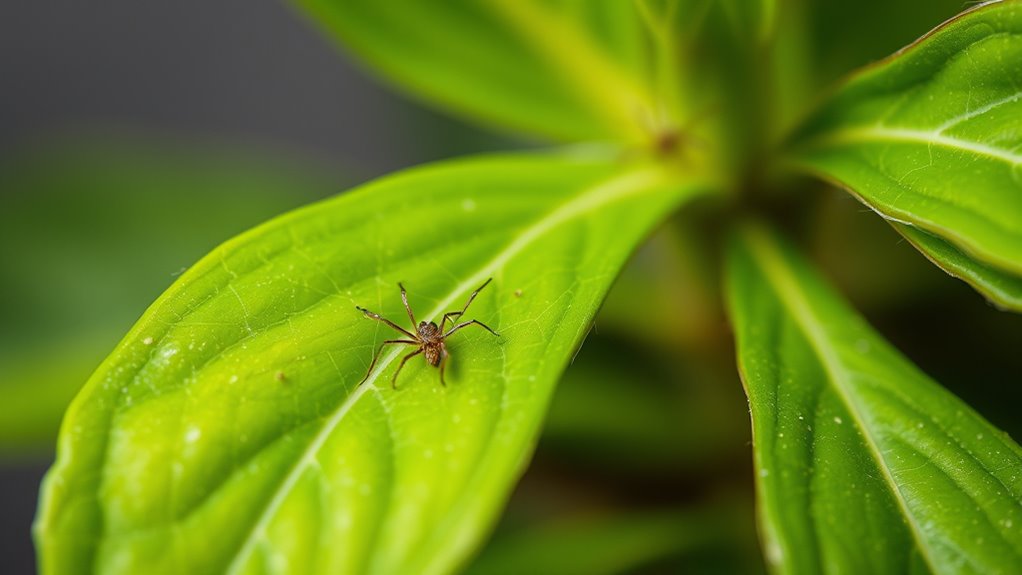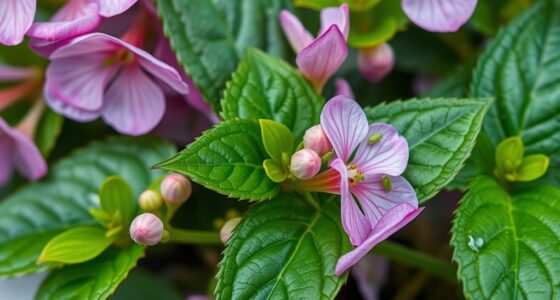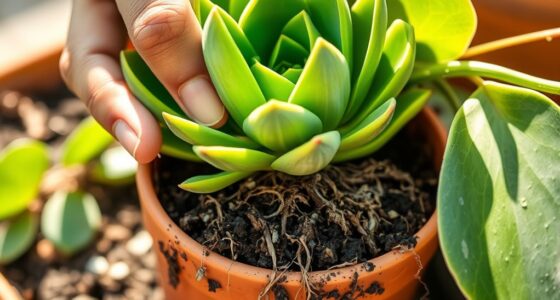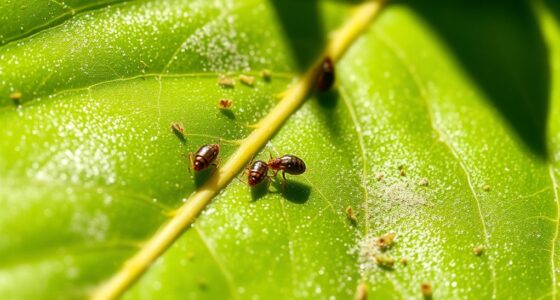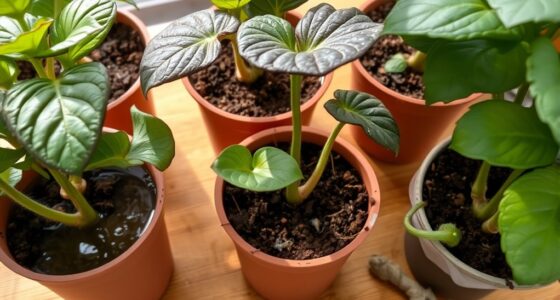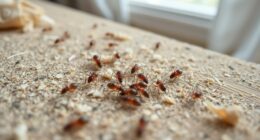To spot spider mites early on your houseplants, look for fine webbing between leaves and stems, along with tiny, moving specks. Check the undersides of leaves where mites often hide, and watch for speckled or stippled patches on foliage. Use a magnifying glass to spot small pests and eggs, which are hard to see with the naked eye. Keeping a close eye on your plants helps catch infestations early—there’s more to learn to keep pests at bay.
Key Takeaways
- Look for fine webbing and stippled, discolored patches on leaf surfaces, especially on undersides.
- Inspect leaves closely with a magnifying glass to spot tiny, moving specks and eggs.
- Monitor early signs like dust-like specks and webbing to catch infestations before they spread.
- Regularly check plants, focusing on leaf undersides and stems, for signs of mites and webbing.
- Track changes over time, noting new spots or worsening damage, to detect early mite activity.
Recognizing the Signs of Spider Mite Infestation
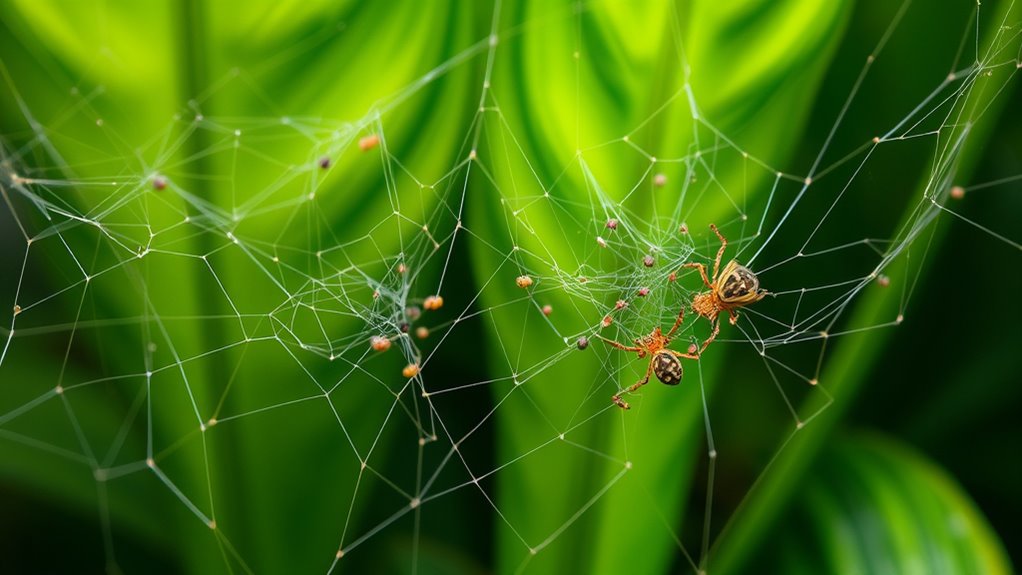
Spider mites are tiny pests that can quickly damage your houseplants, so it’s important to spot them early. You might notice fine webbing on leaves or a dusty, speckled appearance, which are clear signs of infestation. As you inspect, look for tiny, moving dots that are hard to see without close examination. When you detect spider mites, consider biological control options like introducing natural predators such as ladybugs or predatory mites, which can help manage the problem naturally. If you prefer immediate relief, chemical treatments are available; choose acaricides that target spider mites effectively. Combining these methods can provide a balanced approach to control and prevent further damage to your plants. Early detection is key to keeping your houseplants healthy and vibrant.
Examining Your Plants for Tiny Spots and Webbing

To effectively identify a spider mite infestation, carefully examine the leaves of your houseplants for tiny spots and webbing. These signs often appear before visible damage becomes severe, making early detection key to good plant care and pest prevention. Look for:
Early detection of spider mites involves inspecting leaf undersides for tiny spots and webbing.
- Small, speckled spots on leaf surfaces
- Fine, silky webbing between leaves and stems
- Discolored or stippled patches on foliage
- Clusters of tiny, moving specks (spider mites) under the webbing
Pay close attention to the undersides of leaves, where spider mites tend to hide and reproduce. Regular inspections help catch infestations early, reducing the need for harsh treatments and supporting overall plant health. Early detection is your best tool in maintaining pest-free houseplants. Additionally, understanding the rustic decor elements can help you create a cozy environment that encourages healthy plant growth.
Using a Magnifying Glass to Detect Small Pests
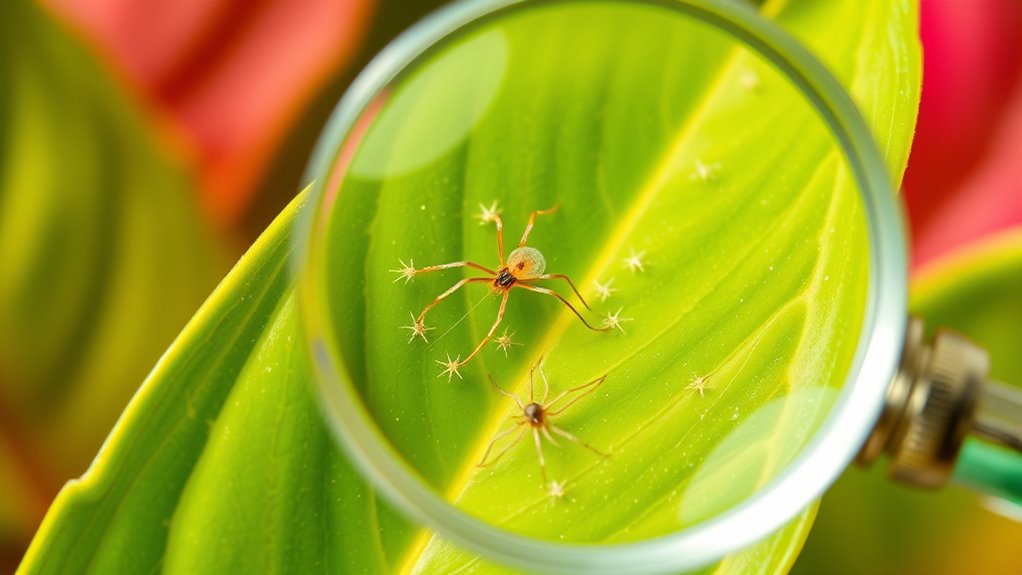
Using a magnifying glass is an essential step in spotting tiny pests like spider mites that often go unnoticed with the naked eye. It enhances your pest identification efforts by allowing you to see small insects, eggs, and webbing clearly. When inspecting your houseplants, hold the magnifying glass close to the leaf surface, especially on the undersides where pests tend to hide. This simple inspection tool helps you distinguish between harmless specks and actual pests, preventing misdiagnosis. Regular use of a magnifying glass makes early detection more reliable, giving you a better chance to control infestations before they spread. Incorporating this tool into your routine ensures you don’t overlook tiny pests, keeping your plants healthy and pest-free. Additionally, understanding the typical pest behaviors can help you identify infestations more quickly and accurately.
Monitoring Plant Damage Over Time

Regularly observing how your houseplants respond to potential pest issues helps you catch problems early. Keep an eye out for subtle changes like yellowing leaves, stippling, or webbing, which can signal spider mite activity. Monitoring damage over time allows you to determine if natural methods, like attracting beneficial insects, are working or if chemical treatments are necessary. Monitoring plant health closely is essential, as early signs of pests are often subtle and easily overlooked.
Consider these key points:
- Track leaf discoloration and texture changes
- Look for fine webbing or tiny moving spots
- Note any new spots or spots worsening
- Assess the effectiveness of beneficial insects or chemical treatments
Consistent monitoring helps you make informed decisions, preventing severe damage and reducing the need for harsh chemicals. Early detection keeps your houseplants healthy and thriving.
Implementing Preventative Inspection Techniques
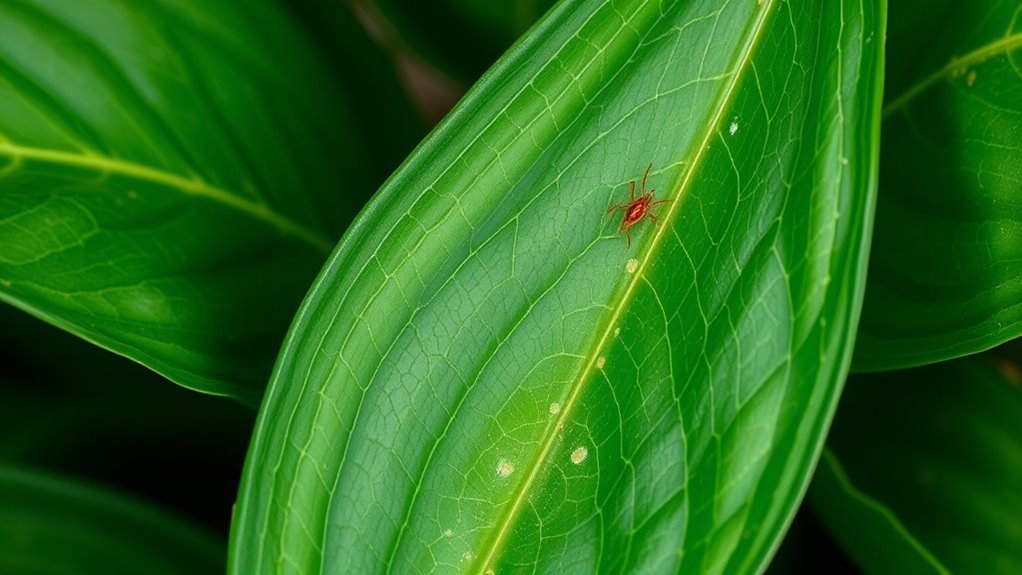
Implementing preventative inspection techniques starts with incorporating routine checks into your plant care routine. Regularly examine your houseplants, paying close attention to soil moisture levels and leaf coloration. Keep the soil consistently moist but not soggy, as overly dry or overly wet conditions can stress plants and make them more susceptible to pests like spider mites. Observe leaf coloration carefully; yellowing or stippling can indicate early mite activity. Use a magnifying glass to inspect the undersides of leaves, where mites often hide. Develop a habit of inspecting your plants weekly, especially during peak indoor pest seasons. Consistent attention helps catch problems early, making it easier to take swift action before significant damage occurs. Monitoring air quality and filtration can also reduce airborne allergens and pests that might affect plant health air purification technology. This proactive approach keeps your plants healthy and spider mite-free.
Frequently Asked Questions
Can Spider Mites Affect All Types of Houseplants Equally?
Not all plant species are affected equally by spider mites. Some plants, like dahlias and strawberries, are more prone to infestations, while others resist them better. The infestation severity varies based on plant species, environmental conditions, and plant health. You should closely monitor vulnerable species, as spider mites can rapidly escalate in severity if left unchecked. Regular inspection helps you catch problems early and prevent severe damage.
Are There Natural Predators to Control Spider Mite Populations Indoors?
Imagine armies of beneficial insects ready to wage war against spider mites! Yes, you can use predator species like ladybugs, predatory mites, and lacewing larvae to naturally control infestations indoors. These beneficial insects act as predator species, hunting down and munching on spider mites without harmful chemicals. Introducing them is like releasing tiny superheroes, keeping your houseplants safe and thriving while maintaining an eco-friendly, chemical-free environment.
How Often Should I Inspect My Plants for Spider Mites?
You should inspect your plants for spider mites at least once a week. Regular pest monitoring helps you catch infestations early, making treatment easier. Look for tiny specks, webbing, or discolored leaves during each inspection. If you notice any signs, act quickly to prevent a larger problem. Consistent inspection frequency keeps your houseplants healthy and pest-free, ensuring you catch issues before they become severe.
Do Spider Mites Transmit Plant Diseases or Viruses?
Think of spider mites as tiny, sneaky messengers, much like a courier delivering viruses. They don’t directly transmit plant viruses, but mite-borne pathogens can carry disease agents that infect plants. While they rarely cause plant virus transmission, their damage weakens plants, making them more susceptible to infections. So, even if they don’t transmit viruses directly, their presence can still lead to disease issues, emphasizing the importance of early detection and control.
What Environmental Conditions Encourage Spider Mite Infestations Indoors?
You’ll find that spider mite infestations indoors thrive when humidity levels drop, making plants more vulnerable. Warm temperatures and frequent temperature fluctuations create ideal conditions for these pests to reproduce rapidly. Keep humidity consistent and avoid sudden temperature changes to reduce their chances of settling in. Regularly inspecting your houseplants and maintaining stable environmental conditions can help prevent a spider mite problem before it starts.
Conclusion
By keeping a close eye on your houseplants, you can spot spider mites early—like catching a whisper before it turns into a storm. Regular inspections with a magnifying glass and watching for tiny spots or webbing help you catch problems early. Think of it as tending a garden of trust; the more attentive you are, the healthier and happier your plants will stay, free from pests and ready to thrive.
